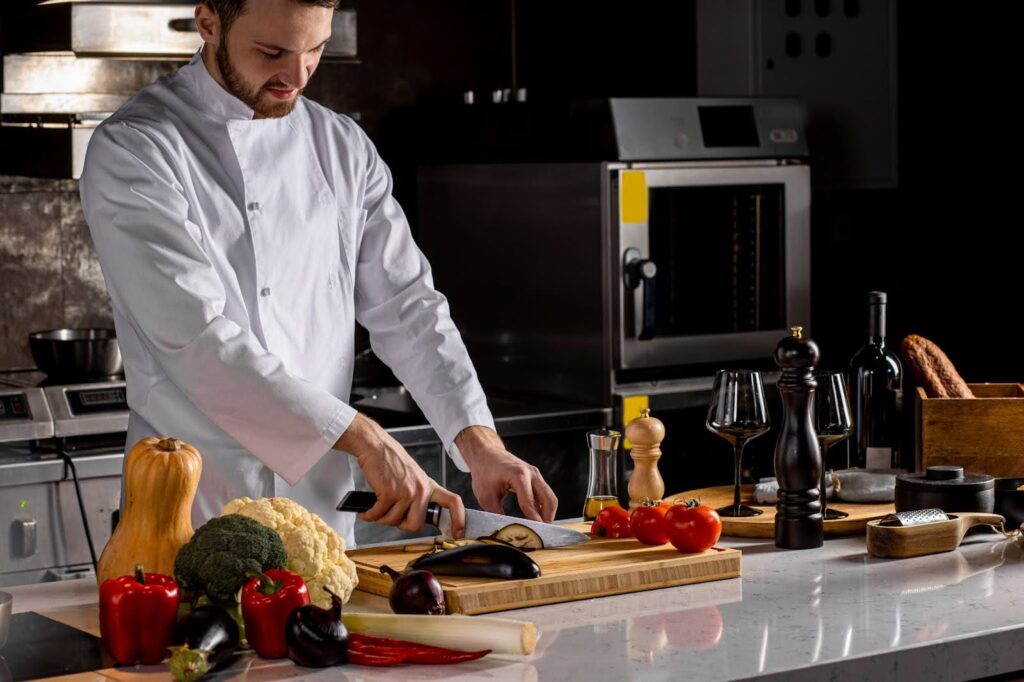Most restaurants try to keep food costs between 28% and 35% of menu prices. However, truly successful restaurants go beyond these basic calculations and optimise their profit margins to ensure every dish on the menu is as profitable as it is delicious. Finding the right balance between costs and pricing requires sophisticated strategies (and a spot of maths) that account for seasonality, cross-utilisation, and psychological pricing techniques. All of this, as well as a refresher on the basics of dish costing, is covered below.
How to maximise profit margins in your restaurant
Let’s start with a refresher on the basics. To calculate food costs, you’ll need to use a food cost percentage formula like this:
Total food cost percentage = (Total cost of ingredients / total revenue) x 100.
For example, if your pasta dish costs £3.50 in ingredients to make and has a selling price of £12 on your menu, you would calculate the following: (3.50/12) x 100 = 29.2%. This means your food cost percentage is 29.2%, which is within the ideal range of 25-35% for profitability. So, that sounds perfect, right?
Well, that formula is a good starting point, but it doesn’t account for the time it takes to make the dish, the wastage and the cost of running the equipment, etc. The more advanced techniques we have below do and ensure you aren’t unknowingly losing out on money.
Beyond basic ingredient costing
Yield testing for accuracy
Yield testing is essential for precise costing, and it’s not as complicated as it sounds. All you need to do is calculate the usable portion of ingredients after trimming, cooking, and processing.
For example, a whole chicken priced at £8/kg might yield only 65% usable meat after breaking it down, making the actual cost closer to £12.30/kg. If this isn’t tracked, you could be losing out on every chicken dish you create.
Track these yields meticulously across all ingredients – especially expensive proteins and produce – to avoid costly miscalculations.
Seasonal menu planning
It’s worth incorporating seasonality into your costing strategy. When ingredients are in season, they’re typically cheaper and of higher quality. Developing seasonal menu rotations takes advantage of these price fluctuations, keeps your creative juices flowing and your customers engaged.
For example, asparagus-focused dishes in spring can be replaced with courgette-based options in summer, maintaining similar margins while adjusting to market conditions. This can easily be marketed to your customers as “seasonal menu changes to keep things fresh and exciting” rather than pricing concerns.
With our produce portal, ordering what’s in season is nice and simple and makes menu planning even easier.
Cross-utilisation mastery
Designing your menu to maximise ingredient cross-utilisation is a great way to ensure you’re getting the most from your raw material costs . For instance, roasted chicken bones from one dish can become stock for risottos or soups, while herb stems can be used in infused oils. This prevents you from buying the same ingredients when it isn’t necessary and keeps costs down without lowering quality.
One way to plan this out is to create a map for your menu and identify opportunities to transform byproducts or “waste” from one dish into components for another – the savings may be small per dish, but they will add up over time.
Recipe testing and refinement
Recipe testing and refinement is another great way of saving money while creating tasty dishes. Your recipes should balance cost and quality. Here’s how:
- Develop the initial recipe based on your culinary vision
- Calculate preliminary costs
- Identify high-cost components
- Test alternative ingredients or techniques
- Reevaluate costs after adjustments
- Conduct blind taste tests to ensure quality isn’t compromised
Changing and refining recipes may not always reduce costs. Sometimes, ingredients just cannot be replaced. Still, any minor adjustments, like reducing a high-cost ingredient by 10% or substituting a different cut of meat, can significantly improve margins without guests noticing any difference in quality.
Advanced labour cost management
Adding a labour cost to each dish is essential to keep profit margins high. After all, if you aren’t sure how much it costs you to pay someone to put the dish together, do you know how much a dish costs you to make?
A basic labour value for each dish may look like this: (Chef’s hourly wage x minutes per dish) / 60. So, if a chef earns £18 per hour and spends 5 minutes making a dish, (18 x 5)/60 = £1.50, for example. More advanced labour calculations can be achieved by analysing prep efficiency.
Break down each dish into its component parts and identify preparation steps that can be batched or streamlined. For example, if five dishes use diced onions, consolidate this prep task to reduce overall labour time.
Having a tiered labour allocation system that assigns different hourly rates to different dishes based on their complexity is a more sophisticated way to calculate costs.. A simple salad might carry a lower labour cost than an intricate dessert requiring specialised skills
Strategic pricing techniques
Psychological pricing strategies
Pricing psychology strategies can include:
- Price anchoring – Position your high-margin items near more expensive options to make them appear more attractive
- Charm pricing – Use prices ending in .95 or .99 for mid-range items to create perceived value
- Prestige pricing – For signature dishes, use round numbers (£30 instead of £29.95) to convey quality.
Menu engineering
Categorising your menu items based on both popularity and profitability is a subtle way to guide people into making menu choices that you want.:
- Stars – High popularity, high profit margin (feature prominently)
- Workhorses – High popularity, lower profit margin (consider recipe refinement)
- Puzzles – Low popularity, high-profit margin (reposition or improve presentation)
- Dogs – Low popularity, low profit margin (replace or revamp)
Review your menu mix monthly and adjust positioning, descriptions, and pricing accordingly.
Special dietary offerings
Develop a specific costing strategy for dietary alternatives. While gluten-free or vegan options often have higher ingredient costs, they can command premium prices if executed well. Calculate the incremental cost of substitutions (e.g., gluten-free pasta vs regular pasta) and price accordingly.
Consider developing signature plant-based dishes that are inherently profitable rather than relying on expensive meat substitutes – a three bean chilli, for example, will be much more profitable than a chilli with a meat alternative.
Beverage pairing strategies
Common place in high-end restaurants, a beverage pairing strategy for your menu, or elements of your menu, is a good way to increase your average order costs, whilst also adding a fantastic dining experience for your customers. You could try creating signature beverage flights or wine-tasting menus that showcase your food with the perfect pairing while boosting profitability.
Inflation adjustment framework
Price adjustments need to happen frequently to ensure that your dishes are not beginning to cost you money.
- Do quarterly cost analyses of your menu
- Identify items where food cost percentages have crept above target
- Implement a tiered adjustment strategy:
- Minor inflation (3-5%): Adjust prices on selected items
- Moderate inflation (5-10%): Implement menu-wide increases
- Severe inflation (10%+): Redesign the menu with alternative ingredients
When increasing prices, consider updating the presentation or portion size simultaneously. This will ensure that any frequent customers will maintain perceived value and look at these changes as menu updates, not price increases.
Staff training for cost management
Develop training programs that emphasise the financial impact of kitchen decisions. Teach portion control techniques, proper storage to prevent spoilage and efficient prep methods.
Create incentive systems that reward staff for waste reduction and cost management. For example, implement a bonus structure tied to maintaining target food cost percentages.
In conclusion
By implementing these strategies, you can maximise your restaurant’s profit margins and create stunning dishes that work for you. However, you can’t do either of these without a reliable, trustworthy supplier of fresh fruit and vegetables. If you’re in London, All Greens is the wholesale fruit and vegetable supplier you need. We also stock a huge range of pantry staples as well as dairy, prepped, dry and frozen goods. Become a customer of All Greens today and order market-fresh produce anytime from anywhere with our handy portal and see why with the trusted supplier of 100s of restaurants and caterers in London already.


